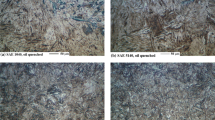Abstract
The 9%Ni low-carbon steel is applied to utilities and processes at temperatures as low as − 196 °C. However, the microstructural features play an important role on the mechanical properties. Notably, the cryogenic toughness and mechanical strength are strongly dependent on the final heat treatment. In this paper, the microstructure of a 9%Ni low-carbon steel was modified by different heat treatments. The hardness and cryogenic toughness were measured and correlated to microstructural features. The material shows a temper embrittlement with intergranular cracking and minimum cryogenic toughness after tempering around 400 °C. Austempering at 480 °C also produced very low toughness results. On the other hand, excellent cryogenic toughness was obtained with single tempering at 600 °C after quenching or normalizing. Even higher toughness was obtained with the double tempering at 670 °C/2 h plus 600 °C/2 h. The amount of reversed austenite and its morphology in the specimen quenched and tempered at 600 °C were shown in the paper.











Similar content being viewed by others
References
J.-I. Jang, J.B. Ju, B.-W. Lee, D. Kwon, and W.-S. Kim, Effects of Microstructural Change on Fracture Characteristics in Coarse Grained heat Affected Zones of QLT-Processed 9%Ni Steel, Mater. Sci. Eng. A, 2004, 340, p 68
X.J. Zhang, Microhardness Characterization in Developing High Strength, High Toughness and Superior Ballistic Resistance Low Carbon Ni Steel, Mater. Sci. Technol., 2012, 28, p 818
Y.-H. Yang, Q.-W. Cai, D. Tang, and H.-B. Wu, Precipitation and Stability of Reversed Austenite in 9Ni Steel, Int. J. Min. Metall. Mater., 2010, 17(5), p 587
X.-Q. Zhao, T. Pan, Q.-F. Wang, H. Su, C.-F. Yang, and Q.-X. Yang, Effect of Tempering Temperature on Microstructure and Mechanical Properties of Steel Containing Ni of 9%, J. Iron Steel Res. Int., 2011, 18(5), p 47
J.M. Zhang, H. Li, F. Yang, O. Chi, L.K. Ji, and Y.R. Feng, Effect of Heat Treatment Process on Mechanical Properties and Microstructure of a 9% Ni Steel for Large LNG Storage Tanks, J. Mat. Eng. Perform., 2013, 24, p 3867
S.S.M. Tavares, J.M. Pardal, G.C. de Souza, C.A.S. de Oliveira, and H.F.G. de Abreu, Influence of Tempering on Microstructure and Mechanical Properties of Ti Alloyed 13%Cr Supermartensitic Stainless Steel, Mater. Sci. Technol., 2014, 30, p 1470
C. Gesnouin, A. Hazarabedian, P. Bruzzoni, J. Ovejero-Garcia, P. Bilmes, and C. Llorente, Effect of Post-Weld Heat Treatment on the Microstructure and Hydrogen Permeation of 13crNiMo Steels, Corros. Sci., 2000, 46, p 1633
P.D. Bilmes, M. Solari, and C.L. Llorente, Characteristics and Effects of Austenite Resulting from Tempering of 13Cr-NiMo Martensitic Steel Weld Metals, Mater. Charac., 2001, 46, p 285
ASTM A-333-16, Standard Specification for Seamless and Welded Steel Pipe for Low-Temperature Service and Other Applications with Required Notch Toughness, ASTM International, West Conshohocken, 2014
ASTM E-23-16a, Standard Test Methods for Notched Bar Impact Testing of Metallic Materials, ASTM International, West Conshohocken, 2016
H.-T. Lee, H.-G. Kim, G.-G. Kim and S.-B. Shin, A Study on the Prediction of Welding Distortion of 9% Ni Steel for the Offshore LNG Storage Tank, Proceedings of the Sixteenth (2007) International Offshore and Polar Engineering Conference, Lisbon, Portugal, July 1-6, 2007.
A.W. Pense, R.D. Stout, Fracture Toughness and Related Characteristics of the Cryogenic Nickel Steels, Welding Research Council Bulletin, 1975, 205
K. Tsuzaki, K. Fujiwara, and T. Maki, Bainite Reaction in Fe-Ni-C Alloys, Mater. Trans. JIM, 1991, 32(8), p 667
D.-S. Leem, Y.-D. Leem, J.H. Jun, and C.-S. Choi, Amount of Retained Austenite at Room After Reverse Transformation in a Fe-13%Cr-7%Ni-3%Si Martensitic Stainless Steel, Scr. Mater., 2001, 45, p 767
ASTM A553-14, Standard Specification for Pressure Vessel Plates, Alloy Steel, Quenched and Tempered 7, 8 and 9% Nickel, ASTM International, West Conshohocken, 2010
P.R. Sreenivasan, Charpy Energy–Lateral Expansion Relations for a Wide Range of Steels, Int. J. Press. Vess. Piping., 2006, 83, p 498
O. Furukimi and Y. Saito, The Effects of Grain Boundary Phosphorus Segregation and Heat Treatment on Toughness of 9%Ni Steel and Its Welded Joint, ISIJ Int., 1991, 30, p 390
J.P. Materkowski and G. Krauss, Temper Martensite Embrittlement in SAE 4340 Steel, Met. Trans. A, 1979, 10, p 1643
Acknowledgments
The authors acknowledge the Brazilian research agencies CNPq, FAPERJ and CAPES.
Author information
Authors and Affiliations
Corresponding author
Rights and permissions
About this article
Cite this article
Tavares, S.S.M., Rodrigues, C.R., de Oliveira, C.A.S. et al. Influence of Heat Treatments on Microstructure and Toughness of 9%Ni Steel. J. of Materi Eng and Perform 27, 1530–1536 (2018). https://doi.org/10.1007/s11665-018-3257-2
Received:
Revised:
Published:
Issue Date:
DOI: https://doi.org/10.1007/s11665-018-3257-2




